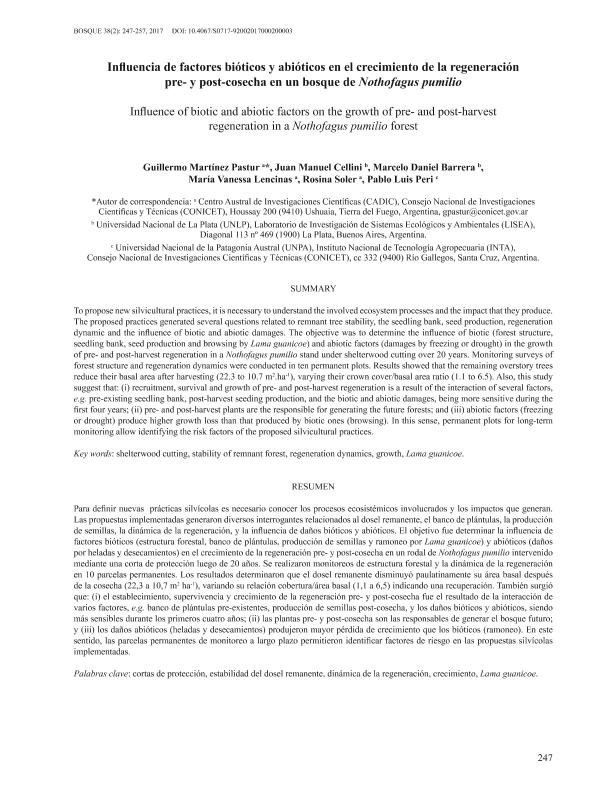Artículo
Para definir nuevas prácticas silvícolas es necesario conocer los procesos ecosistémicos involucrados y los impactos que generan. Las propuestas implementadas generaron diversos interrogantes relacionados al dosel remanente, el banco de plántulas, la producción de semillas, la dinámica de la regeneración, y la influencia de daños bióticos y abióticos. El objetivo fue determinar la influencia de factores bióticos (estructura forestal, banco de plántulas, producción de semillas y ramoneo por Lama guanicoe) y abióticos (daños por heladas y desecamientos) en el crecimiento de la regeneración pre- y post-cosecha en un rodal de Nothofagus pumilio intervenido mediante una corta de protección luego de 20 años. Se realizaron monitoreos de estructura forestal y la dinámica de la regeneración en 10 parcelas permanentes. Los resultados determinaron que el dosel remanente disminuyó paulatinamente su área basal después de la cosecha (22,3 a 10,7 m2 ha-1), variando su relación cobertura/área basal (1,1 a 6,5) indicando una recuperación. También surgió que: (i) el establecimiento, supervivencia y crecimiento de la regeneración pre- y post-cosecha fue el resultado de la interacción de varios factores, e.g. banco de plántulas pre-existentes, producción de semillas post-cosecha, y los daños bióticos y abióticos, siendo más sensibles durante los primeros cuatro años; (ii) las plantas pre- y post-cosecha son las responsables de generar el bosque futuro; y (iii) los daños abióticos (heladas y desecamientos) produjeron mayor pérdida de crecimiento que los bióticos (ramoneo). En este sentido, las parcelas permanentes de monitoreo a largo plazo permitieron identificar factores de riesgo en las propuestas silvícolas implementadas. To propose new silvicultural practices, it is necessary to understand the involved ecosystem processes and the impact that they produce. The proposed practices generated several questions related to remnant tree stability, the seedling bank, seed production, regeneration dynamic and the influence of biotic and abiotic damages. The objective was to determine the influence of biotic (forest structure, seedling bank, seed production and browsing by Lama guanicoe) and abiotic factors (damages by freezing or drought) in the growth of pre-and post-harvest regeneration in a Nothofagus pumilio stand under shelterwood cutting over 20 years. Monitoring surveys of forest structure and regeneration dynamics were conducted in ten permanent plots. Results showed that the remaining overstory trees reduce their basal area after harvesting (22.3 to 10.7 m2 ha-1), varying their crown cover/basal area ratio (1.1 to 6.5). Also, this study suggest that: (i) recruitment, survival and growth of pre-and post-harvest regeneration is a result of the interaction of several factors, e.g. pre-existing seedling bank, post-harvest seeding production, and the biotic and abiotic damages, being more sensitive during the first four years; (ii) pre- and post-harvest plants are the responsible for generating the future forests; and (iii) abiotic factors (freezing or drought) produce higher growth loss than that produced by biotic ones (browsing). In this sense, permanent plots for long-term monitoring allow identifying the risk factors of the proposed silvicultural practices.
Influencia de factores bióticos y abióticos en el crecimiento de la regeneración pre- y post-cosecha en un bosque de Nothofagus pumilio
Título:
Influence of biotic and abiotic factors on the growth of pre-and post-harvest regeneration in a Nothofagus pumilio forest
Martínez Pastur, Guillermo José ; Cellini, Juan Manuel; Barrera, Marcelo Daniel; Lencinas, María Vanessa
; Cellini, Juan Manuel; Barrera, Marcelo Daniel; Lencinas, María Vanessa ; Soler Esteban, Rosina Matilde
; Soler Esteban, Rosina Matilde ; Peri, Pablo Luis
; Peri, Pablo Luis
 ; Cellini, Juan Manuel; Barrera, Marcelo Daniel; Lencinas, María Vanessa
; Cellini, Juan Manuel; Barrera, Marcelo Daniel; Lencinas, María Vanessa ; Soler Esteban, Rosina Matilde
; Soler Esteban, Rosina Matilde ; Peri, Pablo Luis
; Peri, Pablo Luis
Fecha de publicación:
06/2017
Editorial:
Universidad Austral de Chile. Facultad de Ciencias Forestales
Revista:
Bosque (Valdivia)
e-ISSN:
0717-9200
Idioma:
Español
Tipo de recurso:
Artículo publicado
Clasificación temática:
Resumen
Archivos asociados
Licencia
Identificadores
Colecciones
Articulos(CADIC)
Articulos de CENTRO AUSTRAL DE INVESTIGACIONES CIENTIFICAS
Articulos de CENTRO AUSTRAL DE INVESTIGACIONES CIENTIFICAS
Citación
Martínez Pastur, Guillermo José; Cellini, Juan Manuel; Barrera, Marcelo Daniel; Lencinas, María Vanessa; Soler Esteban, Rosina Matilde; et al.; Influencia de factores bióticos y abióticos en el crecimiento de la regeneración pre- y post-cosecha en un bosque de Nothofagus pumilio; Universidad Austral de Chile. Facultad de Ciencias Forestales; Bosque (Valdivia); 38; 2; 6-2017; 247-257
Compartir
Altmétricas



